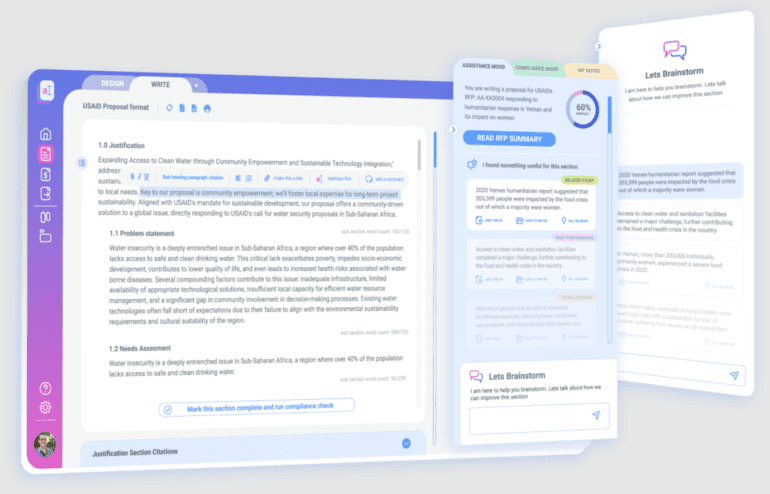TL;DR:
- Grants are vital for organizations, but the proposal process is labor-intensive and time-consuming.
- Grant Assistant, founded by Sean Carroll and a team of experts, offers AI-powered tools to streamline grant proposal creation.
- It complements professional grant writers rather than replacing them.
- Grant Assistant’s approach involves a questionnaire and a “suggestion engine” to enhance proposals.
- The AI model behind Grant Assistant is fine-tuned for complex proposals.
- Concerns about AI hallucination are addressed through the suggestion engine, but user verification remains essential.
- Grant Assistant aims to reduce time and cost in proposal creation and has secured funding for growth.
- The focus is on customer acquisition, with non-binding agreements in place with government contractors.
- Grant Assistant aims to outperform competitors with its integrated tools and user-friendly AI.
Main AI News:
Grants are the lifeblood of many organizations. However, securing them often proves to be a labor-intensive and time-consuming endeavor. Writing a proposal can entail hundreds of hours, the services of a specialized grant writer, and thousands of dollars in expenses – a process that inevitably limits the potential pool of applicants.
Sean Carroll, former Chief of Staff and COO of the U.S. Agency for International Development (USAID), is intimately familiar with the challenges of grant writing. At USAID, an agency responsible for disbursing billions of dollars in civilian foreign aid and development assistance, Carroll oversaw the complex world of grant distribution.
Carroll’s solution? Harness the power of AI to assist in the grant proposal process.
Teaming up with Mustafa Hasnain, the founder of Creative Frontiers, Syed Murtaza, an ex-corporate banker, and Gilberto Lopez, a Harvard academic, Carroll founded Grant Assistant. This innovative platform offers a suite of AI-powered tools designed to guide grant writers through their approach, target beneficiaries and extract valuable insights from relevant documents.
It’s important to note that Grant Assistant is not intended to replace professional grant proposal writers, but rather to augment and support their work.
“Most document creation tools drop the user into a blank writing environment, expecting them to compose the entire document like a polished symphony from a single note,” Carroll explained. “Our experience demonstrates that this isn’t the best approach, as it’s counterintuitive to start from the ‘top’ of a complex and interconnected proposal. Put more simply, you can’t write an executive summary until you’ve completed the substance of the program.”
In contrast, Grant Assistant streamlines the process by having users complete a questionnaire resembling the questions a project consultant might ask. This information informs an AI-generated draft of the grant proposal. Additionally, a “suggestion engine” highlights content from uploaded documents, enriching grant proposals with relevant references.
Carroll remains tight-lipped about the specific generative AI model powering Grant Assistant, only revealing that it’s a “fine-tuned” model. He mentioned, “Model fine-tuning has been done on USAID writing style guides and policy documents. We’re training the tool on writing complex proposals for funders like USAID, the European Union, State-level agencies, the National Institutes of Health, the Department of Energy, and others.“
One lingering concern is whether Grant Assistant has effectively addressed one of the major limitations of generative AI: hallucination. Even advanced text-generating AI can inadvertently present false or misleading information with unwavering confidence, potentially jeopardizing the integrity of a grant proposal.
Carroll contends that Grant Assistant’s suggestion engine, which incorporates research, data points, and citations, serves as a reasonable safeguard against the platform’s proposal-drafting model. However, some may argue that it places the responsibility on the user to verify recommendations from the suggestion engine against the content generated by the proposal-drafting model.
While Grant Assistant is in its early stages, with a team of eight and primarily self-financed, it has secured a $200,000 equity round and a $50,000 grant from Atlantic Philanthropies. As the company matures, it is hoped that it will develop more robust methods to combat hallucination, particularly considering the high stakes involved in grant applications.
In the short term, Grant Assistant’s focus is primarily on customer acquisition, as the company is currently pre-revenue. Nonetheless, it has established non-binding agreements with government contractors in the international development sector, according to Carroll.
With luck, these non-binding agreements will evolve into contracts, positioning Grant Assistant to compete effectively with rivals like Fundwriter.ai and Grantable. Carroll emphasized, “While there are other organizations in the grant writing space, they lack the robust integrated tools, intuitive AI, and practical user flow of Grant Assistant. We believe that Grant Assistant will dramatically reduce the time and cost spent on creating a proposal, letting mission-driven large organizations allocate those saved resources to crucial program delivery, while enabling smaller organizations to compete more effectively with their innovative ideas.”
Conclusion:
Grant Assistant’s innovative approach to grant proposal creation using AI has the potential to revolutionize the market. By addressing the challenges of the grant writing process and providing a user-friendly solution, it aims to attract customers and compete effectively against rivals. This development could lead to increased efficiency and accessibility in the grant application process, benefiting organizations seeking funding.

